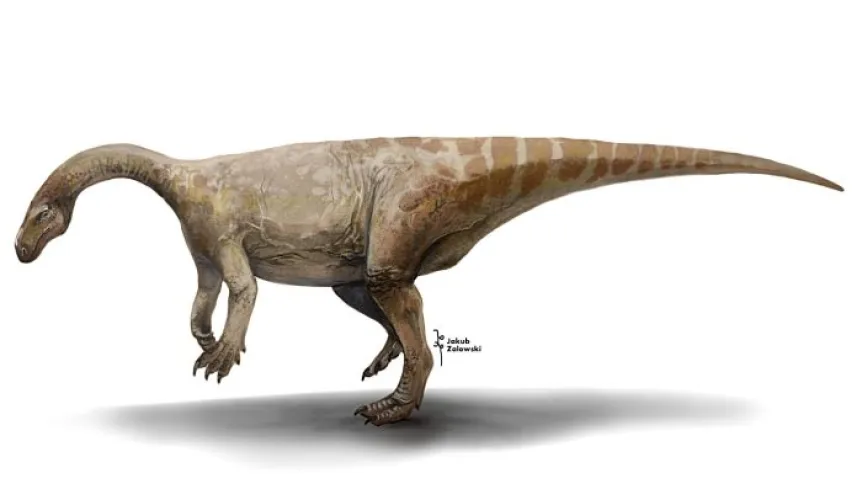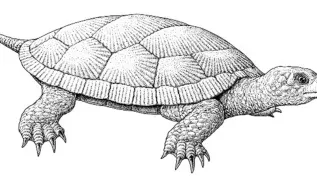
Plateosaurus, one of the largest herbivorous dinosaurs, took about seven breaths per minute, similar to the modern rhinoceros, scientists have calculated. The study co-author is Dr. Justyna Słowiak-Morkovina from the Institute of Paleobiology of the Polish Academy of Sciences.
Plateosaurus trossingensis is one of the largest herbivorous Late Triassic dinosaurs. Numerous fossils of this species, including complete skeletons, have been found in Europe. Thanks to this great fossil record, it is possible to estimate the growth curve, body mass, and even the tidal volume of this dinosaur.
Dr. Słowiak-Morkovina said: “A series of chemical reactions must take place in the body of an animal in order to produce the energy needed for life. These transformations are called metabolism. The rate at which an animal produces energy (metabolic rate) is constant for vertebrates (including dinosaurs) and is calculated using data on changes in the animal's weight with age. As a result, we can find out at what speed the animal consumes oxygen.”
How is the weight of an extinct animal calculated? Previously, scientists based calculations on the femur measurements.
Dr. Słowiak-Morkovina said: “Now palaeontologists create 3D models of dinosaur bodies based on complete skeletons, which to estimate the dinosaur's mass with more precision. Moreover, such models also allow us to estimate the respiratory volume of the animal.”
This type of modelling was done for the Plateosaurus.
Another challenge was to analyse how the animal's weight changed over time. To do this, the researchers examined a cross-section of the femur and counted lines of arrested growth.
Słowiak-Morkovina said: “Such structures appear on the bone cross-section in the season when food is scarce, for example in ungulates in winter, so it is estimated that the arrested growth lines indicate years.”
Combining the passage of years with the calculation of body weight shows how the body weight increased with the age of the animal. “Based on this, we could calculate how much energy the Plateosaurus needed to grow at such a rate. These data, in turn, allowed us to calculate how quickly oxygen was consumed during metabolism,” said Dr. Słowiak-Morkovina.
Another issue to solve was how the dinosaur breathed. For example, birds have air sacs that allow them to breathe more efficiently (oxygen flows through the lungs when inhaling and exhaling); it is called double respiration.
Dr. Słowiak-Morkovina said: “We don't know if Plateosaurus had air sacs, but crocodilians are also capable of double respiration despite the lack of air sacs. Since non-avian dinosaurs (including Plateosaurus) are between crocodilians and birds on the phylogenetic tree, we assumed that they also had this double respiration mechanism. This is also indicated by the previous research of other scientists.”
The next step was to study how much oxygen the animal had to breathe in.
“The efficiency of oxygen extraction from the air in the emu bird in the temperature range, in which the Plateosaurus lived, is 24 plus-minus 2.5 percent. Assuming that the Plateosauruswas similar, we can calculate how much oxygen it must have inhaled; based on the data on oxygen content in the atmosphere in the late Triassic and tidal volume, we counted the number of breaths of Plateosaurus’, said Dr. Słowiak-Morkovina.
To calculate the respiratory rate as accurately as possible, the researchers chose a specific 3D model of Plateosaurus trossingensis - with a body weight of 693 kg and a tidal volume (the volume of air inhaled in each breath) of 2,000 (+/- 500) cm3. The animal's metabolism and oxygen demand were calculated. The oxygen content in the atmosphere in the Late Triassic period when the Platerosaurus lived was also taken into account.
Taking into account how much air it exhaled every minute and knowing its tidal volume, the researchers calculated that the Plateosaurus took about seven (+/- 3) breaths per minute.
Dr. Słowiak-Morkovina said: “This value is similar to modern rhinos. For comparison, the resting respiratory rate in humans is 12-15 breaths per minute.”
The results of the study can be practically used in our time. “A complete picture of the physiological response of animals to environmental and ecological changes in the geological past may influence future strategies for the protection of biodiversity in the age of global climate change,” Dr. Słowiak-Morkovina said.
Find out more in the paper published in The Physics Teacher. (PAP)
PAP - Science in Poland, Magdalena Barcz
bar/ agt/ kap/
tr. RL













